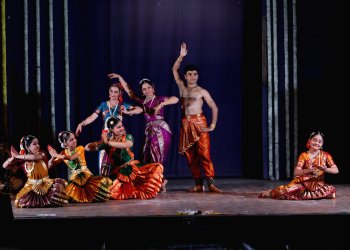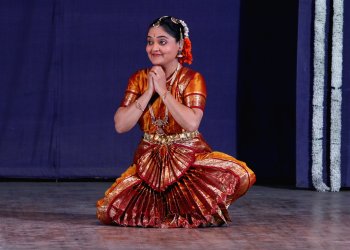
|   |

|   |
An evening to remember - A. Seshan, Mumbai e-mail: anseshan@gmail.com Photos: Sawant's Photo Studio, Thane June 24, 2011 At a time when Margam (Alarippu to Tillana format) is becoming an endangered species in the world of Bharatanatyam (BN), Mumbai aficionados of the art form had a pleasant surprise on June 4, 2011 when Smita Mahajan, a multi-talented dancer with many works to her credit, presented a programme based on the traditional paddhati at the Dadar-Matunga Cultural Centre in Mahim, Mumbai. Despite the city experiencing the severe showers that mark the onset of the south-west monsoon, the auditorium was full testifying to the popularity of the artiste and the format. And the audience stayed till the end.  The programme was entitled ‘Margam-Unmesh.’ ‘Unmesh’ means opening or widening or a flash of light. It was innovative in many respects. Besides seven standard items from Stuti to Varnam it had a cornucopia of as many as six Padams representing the different stayibhavas of five nayikas and one of nayaka too, the last portrayed by a male dancer, and ended with a Tillana and Mangalam. It was sumptuous fare. Marathi songs constituted the repertoire. What was noteworthy was that the lyrics had been written and music composed by Smita herself besides her choreographing of the whole performance. She has more than three decades of experience in the field, having been trained by Sucheta Bhide-Chapekar, the leading light of the banis of Kittappa Pillai and her first guru Natyacharya Parvati Kumar. Along with her gurus, Sucheta pioneered the choreographing in BN of the Marathi works of Shahji and Serfoji, Tanjore kings, and the use of Hindustani music in concerts. Smita is following the trail blazed by her guru. Indu Raman, the doyenne of Kalakshetra artistes in Mumbai, who was the Chief Guest for the evening, pointed out the rare combination of several talents in Smita. She said that we had heard of a vaggeyakara, one who composes a song or kriti and sets it to music too - a combo of a geetkar and a sangeetkar. Smita is an example of an artiste who writes lyrics, sets them to music and also choreographs them besides being a dancer and a guru. She wondered whether there was any term to encapsulate such a combination. Kishori Amonkar, the doyenne of Jaipur-Atrauli Gharana, was the guest of honour and she felicitated Smita and her group. A book entitled ‘Margam-Unmesh’ containing 30 compositions of Smita in Marathi and Hindi in Devanagari script, was released on the occasion. It includes Stuti, Pushpanjali, Kautuvam, Jatiswaram, Shabdam, Varnam, Padam, Tillana and Mangalam – all standard ingredients of Margam. Another innovation was a music performance by B Anantharaman on the violin, Shankar Narayanan on the mridangam and Shaktidharan on the ghatam for about forty minutes before the main programme. They were to accompany the dancers later. It was a mini kutcheri starting with Vatapi in Hamsadhwani and Adi, followed by Sujana Jeevana in Khamas and Adi and ending with a Tillana in Dhanyasi. The alapana, niraval and swaraprastaras were done competently emphasising the jeevaswaras in each raga with the emphasis on the gamakas. Even as it ended there was an encore and the percussionists gave a tani avartanam that was applauded.  The main programme included dances by Smita and her students, viz., Soumya, Anushka, Anwita, Parimal, Alka and Neelima. Suffice it to say that besides giving an outstanding performance herself Smita showcased her talent as a teacher in the manner in which she had prepared her disciples. I liked her Varnam in particular. This is the centrepiece of Margam and the touchstone for testing a dancer’s merit and competence. If full justice is done to the item, as was the case in this instance, it takes 30-40 minutes at the end of which one normally sees the artiste panting for breath – a really vigorous cardio exercise! I was surprised that after doing an expansive Varnam, Smita looked as energetic and fresh as she was at the beginning. The Pantuvarali varnam (“Sakhiye Sajani”) in Adi was about a Vipralabdha nayika who cannot bear the pangs of separation from her husband. The quietness of the night, the moonlight and the cool breeze remind her of him and she is tormented by the arrows of Cupid. She asks her sakhi (friend) to fetch him to be with her. The emotion of viraha was brought out well. Soumya and Anushka made a good and brisk start with their Pushpanjali (“Zem Zem”) in Hamsadhwani and Adi. Kautuvam and Mallari are rare to come by nowadays even in Margam programmes. Devi Kautuvam by Smita, Neelima and Alka (Nattai, Chhandatala) and Mallari by Parimal (Mohanam, Khanda Ekam) were refreshingly welcome. Jatiswaram by Neelima and Alka in Abhogi and Adi presented the essence of pure dance coupled with melody. Anwita’s Shabdam in Ragamalikai in Misra Chapu, (“Govinda Govinda”) portrayed the love of Yashoda, Radha and Meera for Krishna providing scope for sringara with its three sub-divisions, viz., vatsalya, rati and bhakti, respectively. It was Ekaharya (solo dancing of different characters) at its best. It was a masterpiece in conception and execution. Naturally it was a hit with the audience. I am aware of only one other song with all the three types of sringara mentioned above, i.e., “Krishna nee begane baro” of Vyasaraya in Yamuna Kalyani, which is popular with rasikas and dancers alike. After Varnam, the organisers had thoughtfully arranged for snacks and hot cups of coffee and tea that were most welcome to the audience which returned happily to the auditorium! The Padams were presented after the intermission. Those in Khamas - Adi (“Nahi kale maja”), Kapi - Misra Chapu (“Sakhi mi”), Bihag - Adi (“Ruth gai”), Valaji - Adi (“Kahisunikacchu”) and Kalyani - Adi (“Ragavu Kashi Tula”) gave a kaleidoscopic mix of the stayibhavas of different nayikas. Parimal’s padam in Desh and Adi (“Yaha nari ki), portraying a nayaka’s anguish about a nayika was a novelty. There are not many male dancers or padams about nayakas. The nayika is most of the time at the centre of BN. Parimal’s nayaka portrayed his doubt about the love of the nayika whose hide-and-seek attitude was ambivalent. Tillana in Surati and Rupakam (Smita, Nileema and Alka) had the usual features of attractive addamis, artistic poses and fast footwork. The variety of talams for various songs instead of being confined to the easy and even-paced Adi spoke well of the confidence of the choreographer in her command over rhythm. The programme concluded with Mangalam (“Mangal Mangal Hou De”) in Sindhu Bhairavi and Adi performed by all the artistes. In the Tanjavur bani, as exemplified by Kittappa Pillai, music is the centrepiece of BN. As Sucheta has said in an article on the bani, “Dance is visual music.” (“Understanding Tanjavur bani through guru Kittappa”, Shanmukha, Special Issue on Banis in Bharatanatyam and Recent Trends, October-December 2010). The synergistic integration of music and dance each enhancing the other resulting in the total effect being more than the sum of the parts was the highlight of the programme thanks to the excellent support from the side wing. (Refer to “See the Music, Hear the Dance” - Alarmel Valli’s Synaesthetic Approach in). One sees considerable story-telling in the name of sanchari bhavas in Varnam nowadays. On the other hand, Kittappa Pillai felt that Varnam should focus on the expressions of emotions of the nayika. (See Prof Chandrasekhar at the Nalanda Seminar). I found that Smita’s lyric for the Varnam of the evening provided ample scope for this approach. Kittappa Pillai emphasised a relaxed attitude to the execution of the adavus with a full body swing avoiding rigidity and tension that only strained the dancer physically. One could see this aspect of the bani in almost all the dancers. Since the artistes were of different ages and had undergone training for differing periods it was natural that there were some divergences although it was not conspicuous. But one should not miss the wood for the trees. Some tightening up of choreography would ensure that whenever the dancers in a group have to dance in the same way without any individual variation in charis the positions of their limbs (arms and legs) are identical. It should not be difficult to achieve this if music is the anchor for the movements. The orchestra was one of the major factors contributing to the success of the evening. The vocal support of P S Krishnamoorthy and Mangalam Krishnamoorthy was so good that one could have attended the programme for their singing alone. Krishnamoorthy is well known in music and dance circles in Mumbai as an artiste with a command over a number of instruments besides being a vaggeyakara. Prasanna Athale’s nattuvangam was of a high order sustaining the rhythmic support to the dancers. It reflected her long experience in the field. Anantharaman (violin) and Shankar Narayanan (mridangam) gave further evidence of their mastery of the instruments already seen and heard by the audience. The others in the team also should be congratulated for making the event a success: Raju Dabholkar (sound – it was not loud), Sawant’s photo lab (video), Dadar-Matunga Cultural Centre (stage and lights), Shrikant Agashe (make-up) and Sharad Sathe and Aakruti (design). Last but not least was the competent compering of Shailaja Ganguly with her clear articulation of the announcements from time to time. Printset did a professional job in bringing out an attractive brochure on the artistes and the items of dance. Sucheta could not be present as she was in a Kailash-Mansarovar yatra. But she was present in spirit to encourage her disciple to give her best in the evening. I left the auditorium with the satisfaction that the future of Margam is safe and assured in the hands of artistes like Smita. The author, an Economic Consultant in Mumbai, is a music and dance buff. |